#DRM Video Encryption Software
Explore tagged Tumblr posts
Text
DRM Video Encryption Software or DRM Player to protect your video content
128-bit DRM Video Encryption software with DRM Player which protects your videos & content from unauthorized access. Start your free trail now - iShieldProtect®. Start your free trail now 916400 6065
#DRM Video Encryption Software#DRM player#drm video protection software#drm player#drm protection software#drm video encryption#drm software for video#drmprotected video testing#drm protected video testing
0 notes
Text
Why Your Business Needs a Cloud Video Platform Today
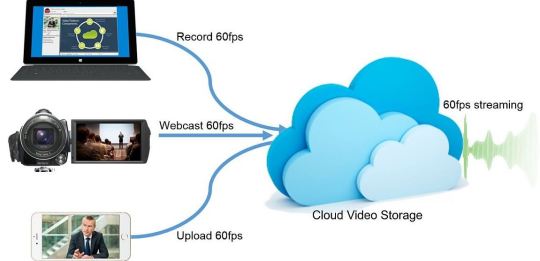
In the digital era, businesses are constantly looking for ways to enhance efficiency, reduce costs, and improve communication and collaboration. One of the technological advances that has been pivotal in achieving these objectives is the cloud video platform. This platform has revolutionized how businesses operate, offering a multitude of benefits ranging from improved communication strategies to expansive data analytics. Additionally, the cloud video platform provides scalable solutions that adapt to the needs of growing businesses, ensuring that they can maintain seamless operations. By facilitating remote work and virtual meetings, these platforms also contribute to better team collaboration and more efficient project management.
Key Benefits of Using Cloud Video Platform
A cloud video platform offers significant advantages to businesses, paramount among them being scalability, accessibility, enhanced collaboration, cost-effectiveness, and security. Understanding these benefits in detail can help organizations make informed decisions about adopting this technology, leading to more efficient operations, improved communication, and ultimately, a competitive edge in the market. Embracing cloud video solutions is a strategic move.
Scalability and Flexibility
One of the primary advantages of cloud video platform is their scalability. Businesses can effortlessly scale their video management needs up or down based on current demand without the need for significant upfront investments in hardware. This flexibility is crucial in adapting to business growth or changes without incurring additional costs or delays. Moreover, it allows companies to efficiently manage resources and respond promptly to evolving market conditions.
Accessibility and Reach
With a cloud video platform, videos can be accessed from anywhere, at any time, on any device with internet access. This global accessibility ensures that employees in different locations can easily participate in training sessions, meetings, and collaborations without the need for physical travel, further enhancing productivity across the organization. Additionally, it allows for seamless integration of remote and on-site teams, fostering a more connected and efficient workplace.
Enhanced Collaboration
A cloud video platform facilitates enhanced collaboration among teams by providing features such as real-time sharing, editing, and communication tools. These integrated features enable teams to work together more effectively, even when members are spread across various geographic locations. This real-time interaction significantly aids in quicker decision-making and problem-solving, ensuring that projects progress smoothly and efficiently regardless of physical distances.
Cost-Effectiveness
Moving to a cloud video platform can significantly reduce costs related to video content management. By leveraging cloud services, businesses eliminate the need for expensive on-premise infrastructure. Additionally, the maintenance and upgrading of systems are handled by the service provider, which can further decrease IT expenses. Furthermore, cloud platforms offer scalable solutions that allow businesses to pay only for the resources they use, optimizing budget allocation.
Security and Compliance
Security is a top concern for any business leveraging digital tools. The cloud video platform is equipped with robust security measures, including data encryption, secure access controls, and compliance with international standards. These features ensure that sensitive content remains protected against unauthorized access and breaches. Additionally, regular security audits and updates further enhance the platform's ability to safeguard valuable data, providing businesses with peace of mind and confidence in their digital security.
Improved Content Management and Analytics
A cloud video platform also offers advanced content management systems, allowing businesses to efficiently organize, manage, and retrieve video content with ease. Additionally, these platforms provide insightful analytics on viewer engagement, content performance, and other key metrics. This data-driven approach enables businesses to make informed decisions to optimize their video strategies, enhance viewer experience, and ultimately drive better results in their video marketing efforts.
Implementing Cloud Video Platform: Considerations and Best Practices
Implementing a cloud video platform yields significant benefits, but its success hinges on strategic planning and factor consideration. Vital elements encompass selecting an appropriate platform, meeting bandwidth needs, prioritizing user adoption tactics, and upholding data governance policies. These measures collectively shape a robust foundation for seamless integration and optimized performance.
Choosing the Right Platform
Selecting the appropriate cloud video platform is critical and should be based on specific business needs such as feature requirements, scalability, security, and compatibility with existing systems. Businesses should conduct thorough research or consult with experts to find the best fit.
Ensuring Adequate Bandwidth
Effective video streaming requires sufficient bandwidth. Before implementation, businesses need to assess their internet bandwidth to ensure smooth video playback and uploading capabilities without disrupting other business operations.
Focusing on User Adoption
To maximize the benefits of cloud video platform, promoting user adoption through training and support is essential. Employees need to understand how to use the platform efficiently and be comfortable with its features to fully leverage its capabilities.
Adhering to Data Governance
Businesses must also consider data governance when implementing cloud video platform. Ensuring that the platform complies with relevant laws and regulations regarding data privacy and protection is crucial.
Conclusion
The adoption of a cloud video platform can bring transformative benefits to businesses, fostering better communication and collaboration, providing scalability and flexibility, enhancing content management and analytics, reducing costs, and bolstering security. By leveraging cloud technology, organizations can streamline their operations and improve efficiency. Moreover, these platforms enable seamless remote work, support real-time collaboration, and offer advanced tools for data-driven decision-making. With careful planning and consideration of the key factors outlined above, organizations can effectively implement and use these platforms to achieve substantial business success, ensuring they stay competitive in an increasingly digital and connected world. please don’t hesitate to contact us via email or phone for further assistance!
#cloud video platform#secure video hosting#streaming video hosting#encrypted video hosting#drm encrypted video streaming#encrypted video streaming#DRM software#video hosting#security video#video platforms#online video platform#video watermark#DRM protected content#video cdn#wide vine#online courses#e-learning platforms#influencers#paid online courses#E-Learning Solutions#Digital content
0 notes
Text
PSA: Free Software
Reading this may really save your time, privacy, and money! Reblog or share to spread awareness!
Folks often use software that’s expensive and sometimes even inferior because they don’t know there are alternatives. So to those unfamiliar: basically, free and open-source (FOSS) or "libre" software is free to use and anyone can access the original code to make their own version or work on fixing problems.
That does not mean anyone can randomly add a virus and give it to everyone—any respectable libre project has checks in place to make sure changes to the official version are good! Libre software is typically developed by communities who really care about the quality of the software as a goal in itself.
There are libre alternatives to many well-known programs that do everything an average user needs (find out more under the cut!) for free with no DRM, license keys, or subscriptions.
Using libre software when possible is an easy way to fight against and free yourself from corporate greed while actually being more convenient in many cases! If you need an app to do something, perhaps try searching online for things like:
foss [whatever it is]
libre [whatever it is]
open source [whatever it is]
Feel free to recommend more libre software in the tags, replies, comments, or whatever you freaks like to do!
Some Libre Software I Personally Enjoy…
LibreOffice
LibreOffice is an office suite, much like Microsoft Office. It includes equivalents for apps like Word, Excel, and Powerpoint, which can view and edit files created for those apps.
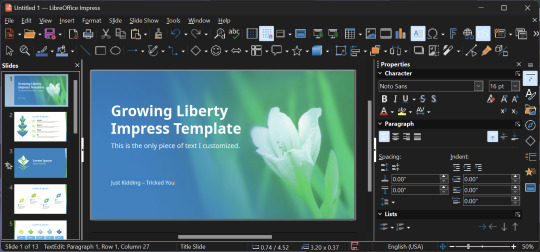
I can't say I've used it much myself yet. I do not personally like using office software except when I have to for school.
OpenShot
OpenShot Video Editor is, as the name suggests, a video editing program. It has industry-standard features like splicing, layering, transitions, and greenscreen.
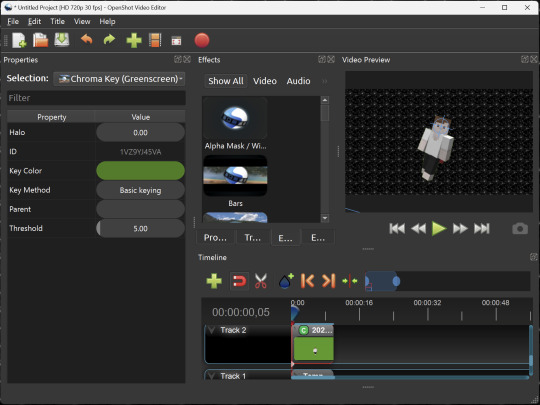
I've only made one video with it so far, but I'm already very happy with it. I had already paid for a video editor (Cyberlink PowerDirector Pro), but I needed to reinstall it and I didn't remember how. Out of desperation, I searched up "FOSS video editor" and I'm so glad I did. There's no launcher, there's no promotion of other apps and asset packs—it's just a video editor with a normal installer.
GIMP
GNU Image Manipulation Program is an image editor, much like Photoshop. Originally created for Linux but also available for Windows and MacOS, it provides plenty of functionality for editing images. It is a bit unintuitive to learn at first, though.

I've used it to create and modify images for years, including logos, really bad traceover art, and Minecraft textures. It doesn't have certain advanced tech like AI paint-in, but it has served my purposes well and it might just work for yours!
(Be sure to go to Windows > Dockable Dialogs > Colors. I have no idea why that's not enabled by default.)
Audacity
Audacity is an audio editing program. It can record, load, splice, and layer audio files and apply effects to them.

Audacity is another program I've used for a long time. It is not designed to compose music, but it is great for podcasts, simple edits, and loading legacy MS Paint to hear cool noises.
7-Zip
7-Zip is a file manager and archive tool. It supports many archive types including ZIP, RAR, TAR, and its own format, 7Z. It can view and modify the contents of archives, encrypt and decrypt archives, and all that good stuff.

Personally, I use 7-Zip to look inside JAR files for Minecraft reasons. I must admit that its UI is ugly.
Firefox
Firefox is an internet browser, much like Google Chrome, Microsoft Edge, or Safari. While browsers are free, many of them include tracking or other anti-consumer practices. For example, Google plans to release an update to Chromium (the base that most browsers are built from these days) that makes ad blockers less effective by removing the APIs they currently rely on.
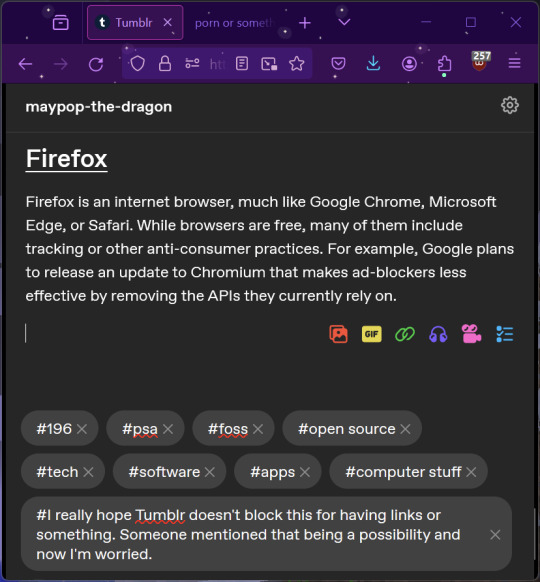
Aside from fighting monopolies, benefits include: support for animated themes (the one in the picture is Purple Night Theme), good ad blockers forever, an (albeit hidden) compact UI option (available on about:config), and a cute fox icon.
uBlock Origin
As far as I know, uBlock Origin is one of the best ad blockers there is.
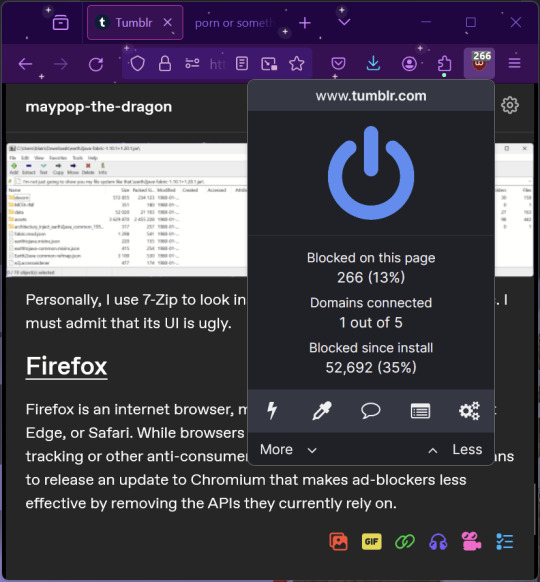
I was on a sketchy website with my brother, and he was using Opera GX's ad blocker. Much of the time when he clicked on anything, it would take us to a random sponsored page. I suggested that he try uBlock Origin, and with uBlock Origin, that didn't happen anymore.
Linux
Linux is a kernel, but the term is often used to refer to operating systems (much like Windows or MacOS) built on it. There are many different Linux-based operating systems (or "distros") to choose from, but apps made for Linux usually work on most popular distros. You can also use many normally Windows-only apps on Linux through compatibility layers like WINE.


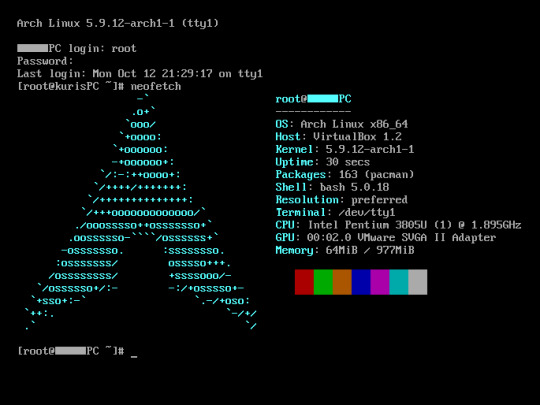
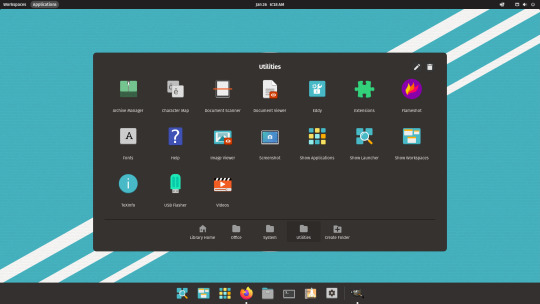
I don't have all four of these, so the images are from Wikipedia. I tried to show a variety of Linux distros made for different kinds of users.
If you want to replace your operating system, I recommend being very careful because you can end up breaking things. Many computer manufacturers don't care about supporting Linux, meaning that things may not work (Nvidia graphic cards notoriously have issues on Linux, for example).
Personally, I tried installing Pop!_OS on a laptop, and the sound output mysteriously doesn't work. I may try switching to Arch Linux, since it is extremely customizable and I might be able to experiment until I find a configuration where the audio works.
Many Linux distros offer "Live USB" functionality, which works as both a demo and an installer. You should thoroughly test your distro on a Live USB session before you actually install it to be absolutely sure that everything works. Even if it seems fine, you should probably look into dual-booting with your existing operating system, just in case you need it for some reason.
Happy computering!
#196#psa#foss#open source#tech#software#apps#computer stuff#I really hope Tumblr doesn't block this for having links or something. Someone mentioned that being a possibility and now I'm worried.#please reblog#2024-01-26
44 notes
·
View notes
Text
Physical media discourse on here feels... weird (this is a long post)
I agree on a fundamental level that the move towards drm-based streaming licenses is bad, and that the perpetual-personal-content license (read: the license most DVDs are under) is a thing we should maintain, at least as a stopgap until the vanguard of communism empowers us to rewrite IP law.
That said, the language positioning Physical vs Digital, the insistence that anything other than physical media is bad, and the upholding of DVDs as a gold standard, all read to me as kinda tech-iliterate, and thus ignorant of the real issue at hand.
The primary issue with streaming, which folks on Tumblr *have* correctly identified, is to do with Access control.
The primary issue with streaming is that it requires a regular subscription payment, to exclusively view content under a license that can be revoked at any time for any reason.
This is the mechanism by which Netflix can kick you off your friend's account, this is also the mechanism by HBO can scrub Infinity Train from existence as a tax write-off.
This system is unequivocally bad, and the reason it's bad is because of DRM and Access Control. This may seem pedantic, but is an important distinction.
Let's take a look at DVDs now. Most DVDs are distributed under a license that grants you perpetual access to view in a private setting, but not to redistribute the content.
This is what that FBI warning that plays at the top of every DVD is trying to tell you, and is why ripping a DVD, while simple, is technically illegal.
Because the video file is hard-encoded into the DVD, and its proliferation largely predates the IOT zeitgeist, *most* DVDs don't contain any access control measures beyond that legal text, but this is not universal.
youtube
This is a great video outlining FlexPlay, an ill-faded technology that used a disk with light-sensitive material, that over the course of about a week or two, blacked out the disk rendering its contents un-viewable.
I bring this up because it highlights two issues.
One, DVDs aren't a physically resilient technology.
Disks are fragile, and even moderate scratches or damage can render a disk unreadable. This is a point of contention retro gamers have had for years, because while their NES cartridges still work, their PS1 disks don't.
This is not even to mention how the plastic of every broken disk still exists somewhere in the world, and will for centuries.
Two, it shows that IP conglomerates, have been at this for years, and won't be stopped in putting Access control into DVDs.
This means that buying DVDs of new shows forever is not an end-game solution. Unless you are content to stop consuming new media, eventually you're going to encounter a DRM protected disk.
To use another more recent example, remember when the Xbox One came out? They had this giant controversy over how playing a game locally on the disk still required online access to Microsoft's servers.
Your physical media could be locked right up for any reason by the platform itself. How can we trust that if DVDs or Blu Ray made a comeback that they would not suffer the same fate?
So where do we go from here, if physical media isn't safe?
Let's consider what digital video *is*. It's a file, same as any other. .mp4 .mov
Some, like .mp4 support DRM-encryption (although don't always contain any). Others, like .ogv exist free from DRM, thanks open source software developers.
Likewise, with a DRM encrypted digital file, because all of the data is hosted locally, just encrypted, there are ways to remove or bypass that encryption, because the VAST majority of cyber-security depends on a lack of knowledge.
This website has a number of very good resources both on drm-free digital storage mediums, and the process of removing certain types of DRM from digital files, (and was my primary resource for this paragraph)
https://www.defectivebydesign.org/so_youve_got_some_questions_do_you#:~:text=To%20avoid%20DRM%20and%20other,webm)%2C%20or%20Daala.
Storing your media as unlocked files presents the best of both worlds.
You have full control over access to your media, you own those files just as much as you own the hard drive you store them on.
You can buy media online, so long as the distributor gives you a media file instead of a streaming portal. You can also choose to obtain media files through other means, that's none of my business.
And you can do some really cool stuff like setting up a self-hosted media server, allowing you streaming-like remote access to all of your media, without ceding any ownership over that media. (Jellyfin is the most popular open-source solution but there are others) https://jellyfin.org/
And absolutely none of this is to mention the ways in which you can SUPPORT YOUR LOCAL LIBRARY, WHO MOST LIKELY HAS STREAMING OPTIONS.
In the US most public libraries maintain Kanopy and hoopla memberships, allowing you to access streamed content from your local library.
This has the added benefit of keeping the library's usage statistics up, which often helps them with securing more funding.
While you don't own the media, you also don't have to pay for it, and you crucially don't have to give your money to streaming services and IP hoarders.
It requires 0 technical background, and presents a more sustainable and equitable view of what streaming can look like.
So in conclusion:
Make sure you own the content you're paying for, and accept nothing less.
Don't be convinced that your DVDs are immune.
Learn some basics about networking, filetypes, cyber security and self-hosting if you really care about this stuff.
Support Open Source Software
Support Your Local Library
5 notes
·
View notes
Text
Game Devs and Player Mods and Tools
I have been carefully considering access to player information, and the various tools allowed (or not) by Game Devs, and how to ensure Data Security.
This particular post was inspired by a certain "Player Stalking Mod" made available.
As a highly skilled and competent (sometimes competitive, but never for cash) player; I'm not above Tools, UI mods, and other "Performance Recording Drugs".
These tools often get used against individuals in a community. From this mod in particular, to the relatively safe indicators and performance reporting tools, to even *information* sent through discord channels of influencial groups.
One particular scam // Doxing Spam; includes a message that says something akin to "Discord#### can hack you by being in your discord, please repost and Ban/Block"
Certain Discord Users do have their own individual profiles and can *appear* to be Users and are really Tools and Bots that help manage a discord or notify participants about scheduling things.
Discord is just Microsoft Teams for Unprofessionals.
Those Discord Bots, when not set-up correctly, either by the author of the Bot, or by the Discord channel owner *can* have the power to be detrimental; but the Discord Team seems ahead of the curve on this one... Though they are not immune.
But spams and doxxing attempts as in that post; should be pretty common-knowledge these days as "Do not repost this crap because it's spam AND/OR doxxing"
But you know; new people are being made everyday.
I've been very interested in Data Security and how it relates to Video Games (Especially Online ones) and these mods and how the data might be used is often in the front of my mind.
Mostly because *more* security requires *more* overhead and is *more* costly to implement. But without it; Video Games are very easily hackable (Every piece of software you install on your device is very easy to hack, the trick is blocking external users from hacking *you* specifically)
This is simply how software works. And there are often "Reverse Engineering" communities that work towards discovering how things are made, or how things can be modified or reused (like In Collage Art) and other fun stuff that many enjoy.
Competitively; this means you need a lot of the hacakables in a remote server so that player competition can be a high priority.
So there's a precarious balancing act between what data gets sent to the User side; and what data doesn't. And it's, more often than not, balanced around total cost; to run and secure a server, quality of life for players, and most importantly; bandwidth.
I give a lot of crap to Publishers and Developers. However, please know; it's because I hold what you do in a very high esteem.
It's not an easy balancing act, and even when I'm critical; it's always admirable. Which sometimes may be overshadowed by my personality... But whatever.
This question is often asked by Software Developers and Online Content Hosts; Which data do we send to the user, and which do we not?
Because all the data you send out; has the potential to be used. Even when encrypted. Much to the Chagrin of Apple and Microsoft DRM teams after hackers unlocked their content blocks. And much to the Chagrin of content Hosts like Netflix and Hulu.
But; that's the trade off. You want people to view your stuff; so encryption works as a hurdle between those end-to-end content Viewers; which may even prevent subscribed viewers from actually viewing the content they stream as well.
(I will *not* teach you how to download your Netflix so you can unsubscribe... Without a DVR.)
When it comes to Online Games however; it *seems* simple enough what should go to the user and what shouldn't.
Take Card Battlers; you'd think it would be easy enough to simply send each player their hand and what cards their opponents are playing.
And yeeeet.
Players can do things like "View cards in your opponents hand or Deck" track which cards have and haven't been played (especially if there's a fixed order hand) AND even... Know what's in your deck from official sources.
Usually from players with tracking tools monitoring your deck as it is played (and updated at the end of a match, and that is uploaded to another server)
And all of those separate tools; despite not being integrated, or intended to be, can be integrated.
Sometimes they can't see exactly what you might have in hand; but with an AI % best card order to play they can use *that* to Make an educated guess as to what *you're* going to play.
<aside>I made a side note to some players when I started playing as LilacLoa about all the Bots playing; to which I was swiftly informed "Those are not Bots... Those are *real* ranked players..."
And then they quietly DMd later after they realized the ubiquitous AI assisted tools resulting in what appears to be Bot-Like Play.
Because I may be an inexperienced Dev, But I'm the expert on this side!
Anyway; I'm a 5-Star Legendary--Suck it.</aside>
It would be very hard to use those particular tools in organized tournaments; but not impossible. However; AI can currently be flattened because those particular decks require very simple builds and automation.
Where experienced players *might* use AI-Assisted information to assist their decisions; a more complex Deck means those are simply AI-Assisted "Suggestions" than what should be played *absolutely*.
And so it goes; The more mechanical a Game is; The more reliant on Hacks and Tools a player might be. Consider Macros from Peripheral Manufacturers like Razer or Logitech; That a player may use to help automate boring tasks (like crafting or gathering) or even for, what are *supposed* to be hard raids that Tool Assistants *shouldn't* be able to do without a player.
Not saying people should or shouldn't; while Turbo Controllers are an honored age-old tradition for Newbie Gamers--Using them in ways that are superior to "Manual Entry" is where it becomes iffy.
And Developers should (and probably have been) work on methods to ensure that Tool Assistance is the sub-optimal way of playing.
However; we're still up against that careful balancing act. Mechanical Entry is the cheapest way to do ant particular thing.
This is the first in a series... The next Topic will cover Data shared with players more in-depth.
0 notes
Text
Price: [price_with_discount] (as of [price_update_date] - Details) [ad_1] 1)Protect your privacy: Enable all data to be protected by password and touch ID, your privacy will not be stolen even you lose the flash drive..2)Mini Size and easy to carry: Light weight,as small as lipsticks,keychain hole makes it easy to carry when you on trip.3)Works with most cases: The iDiskk photo stick is designed with a 4mm longer connector to connect directly into your devices without having to remove your case. 4)Enough External Storage Space : 512GB External Storage can store 256000 photos, or 640 hours HD videos,or 128000 songs,grab more seasons of favorite TV shows, listen to more podcasts, and never worry about using up more space on your idevice without using iTunes or iCloud 5)Verstaile Compatibility: Files:doc, ppt, xls, xlsx, pdf, html, txt Photos:gif, jpg, png,jpeg Videos:avi, flv, m4v, mkv, mov, mp4, rmvb Music:m4a, aiff, caf, mp3, wav Pls Kindly Note:1. If necessary, please remove your phone case first.2. You cannot transfer Music and Video files in iTunes or downloaded by the 3rd APP to the flash drive, as they are DRM (Digital Rights Management) protected. 3. You need to install ""iDiskk Max"" app from App Store before connecting with your device.Package Content::iDiskk photo stick flash Drive 512GB*1 User Manual *1 1- 【COMPATIBLE DEVICES】- iPhone 14 Pro Max, iPhone 14 Pro, iPhone 14 Plus, iPhone 14, iPhone SE (3rd), iPhone 13 Pro Max, iPhone13 Pro, iPhone13, iPhone13Mini, iPhone 12 Pro Max, iPhone 12 Pro, iPhone 12, iPhone 12Mini, iPhone 11 Pro Max, iPhone 11 Pro, iPhone 11, iPhone SE (2nd), iPhone XR, iPhone XS Max, iPhone XS, iPhone X, iPhone 8 Plus, iPhone 8, iPhone 7 Plus, iPhone 7, iPhone SE (1st), iPhone 6S Plus, iPhone 6S, iPhone 6 Plus, iPhone 6, iPhone 5S, iPad 5/6/7/8/9, Mini 2/3/4/5/6 iPad Air Serie, iPad Pro(Lightning connector)(iPhone/iPad/iPad Pro Requires iOS 9.0 or later), iPod touch (6th, 7th), Win11/Win10/Win8/Win7,PC,Laptop,Mac Requires macOS 11.0 or later and a Mac 2-【WATCH MOVIES DIRECTLY and ViEW Photos or Videos FROM THE PHOTO STICK】 -Connect and play,enjoy movies or musics stored in the flash drive when you are on trip or travel, most video formats are supported: (VIDEOS: AVI, M4V, MKV, MOV, MP4, MPG, RM, RMVB, TS, WMV, FLV, 3GP; AUDIOS:FLAC, APE, AAC, AIF, M4A, MP3, WAV) 3- 【AUTOMATIC PHOTO or VEDIO BACKUP】 -Every time you connect the flash drive in, use "iDiskk Max" App camera to take photos/video ,which will be automatically stored into the flash drive. 4- 【HIGH-SPEED TRANSFERS WITH USB 3.0】 -Mfi Certified flash drive guarantees fast and stable data transfers,one HD movies ( approx. 1GB) only needs about 20s. 5- 【24 MONTHS】 - The lightning connector is Mfi certified and stable App software, and encrypted protection will maintain your privacy undisclosed.24 Months Worry-free Waranty & email customer support. 6-【App-le Mfi Certified iPhone PHOTO STICK- 512GB EXTERNAL STOGRAE OF PHOTO STICK 】-The Photo Stick offers an easy and speedy way to transfer photos and videos. Let you free up memory on your mobile devices without using a cable or iCloud or WIFI(6th, 7th), Win11/Win10/Win8/Win7,PC,Laptop,Mac Requires macOS 11.0 or later and a Mac [ad_2]
0 notes
Text
Are you looking for a DVD Ripper software that's extremely versatile? Look no further! This freebie includes MacX DVD Ripper Pro For Windows software that have so many great features. Not only can it be used to rip DVDs, it can also be used to convert and store wide variety of video formats. There are many other DVD Ripper softwares available on web. However, MacX DVD Ripper Pro For Windows software is a premium software that is being offered for free for limited time. This offer is exclusively brought for fromdev readers. This offer is valid for (5 lucky winners) only up to end of August 2015. This offer is for lifetime license for one PC (no upgrades to software). How To Enter Contest Follow the steps below to participate. About MacX DVD Ripper Pro For Windows Every family should have at least one movie DVD or a TV series DVD. However, the DVDs are too vulnerable to be kept for years, especially after the kids scratch them or if you play the discs for many times. Another problem you should have noticed is that the DVDs will become useless once something goes wrong in your DVD player or the computer's DVD drive. If you have a digital backup of the DVD movie, things would be much easier. MacX DVD Ripper Pro for Windows is a very useful software that every family should have as it allows you to not just rip and convert DVD movie to digital video files onto your computer hard drive, it also offers you a fast solution to convert the DVD for playback on your iPad, tablet or smart phone on the go. Rip And Convert DVD To AVI, MP4, FLV, WMV, MOV Mainstream Videos MacX DVD Ripper Pro for Windows provides you with an easy fast way to rip and convert DVD to all mainstream video formats, including AVI, FLV, MP4, MOV, WMV etc. You could later share and edit the video; play the movie at your computer without having to use a home DVD player or DVD driver in your computer. Support New Copy Protections This DVD ripper for Windows (Windows 10 supported) gets constantly update to support the latest DVD copy protections, for instance, CSS encryption, Sony ARccOS encryption, RCE Region protection and even the newly released Disney X-project DRM. You can always count on MacX DVD Ripper Pro for Windows to backup any DVD you own. Copy DVD To Hard Drive And USB Another highlight of this DVD ripping software is that it allows you to copy the full DVD or main content of movie to one single MPEG-2 file with 5.1 Channel AC3/DTS Dolby audio and high definition. With only 5 minutes, you can backup your 2-hour DVD movie without cutting down the quality and own a complete digital copy. Rip DVD Straight To IPhone, IPod, IPad, PSP, Mobile Phone You would not be confined to playing DVD at home on the DVD player or DVD drive. Built in over 370 profiles, this DVD ripper is capable enough to convert DVD and output videos compatible mobile devices , giving you the freedom to enjoy the movie on iPhone 6/6 Plus, iPad/Air 2, HTC Desire 816, Samsung Galaxy S5 mini/5/4, Galaxy Tab S, Surface Pro 3 and more.
0 notes
Text
What Does a Video Downloader Do?
A video downloader is a software or application that enables users to save videos from online platforms, websites, or streaming services directly to their devices. These tools bypass the need for an active internet connection to replay videos, offering a seamless offline viewing experience. Video downloaders are widely used for educational, entertainment, or archival purposes.

Key Features of a Video Downloader
These tools provide an option to download content directly to your device, making it accessible offline. Here's what video downloaders typically do:
Platform Compatibility: Most video downloaders support popular sites like YT, Facebook, Vimeo, and more.
Resolution Options: Users can choose between various video qualities, such as 480p, 720p, 1080p, or even 4K.
Batch Downloading: Advanced tools allow simultaneous downloading of multiple videos.
File Conversion: Some downloaders provide options to convert videos into different formats (e.g., MP4, AVI, or MP3).
Where Does a Video Downloader Save Files?
The default location for downloaded videos depends on the application settings and the operating system in use. Here is a breakdown:
Windows and macOS
Downloaded files are typically saved in the Downloads folder. Some applications also allow users to set a custom directory.
Android
On Android devices, videos are usually stored in the Downloads or Videos folder. Applications like Vidmate may create a dedicated directory within the file system.
iOS
For iPhones and iPads, downloaded videos are often stored within the app’s local storage, accessible via the Files app or the application interface.
Customization Options
Most video downloaders offer users the ability to specify the destination folder during setup or via settings. This flexibility ensures easier file management and organization.
Why Does a Video Downloader Not Work?
Video downloaders can occasionally encounter issues. Common reasons include:
Platform Restrictions
Some websites implement encryption or DRM (Digital Rights Management) to prevent video downloads. Platforms may update their algorithms, rendering some downloaders temporarily ineffective.
Internet Connection Issues
A poor or unstable connection can disrupt the downloading process. Ensure you have a reliable and strong internet connection.
Outdated Software
Using an outdated version of the downloader can lead to compatibility issues. Regular updates ensure that the tool adapts to changes in website structures.
Insufficient Device Storage
A full storage drive can prevent successful downloads. Always check your available storage before downloading large files.
Incorrect URL or Unsupported Format
Inputting an incorrect or invalid video URL will result in failure. Some tools may not support specific formats or websites. Troubleshooting tips:
Ensure you’re using a reliable and up-to-date downloader. Double-check the video URL and your internet connection.
Is a Video Downloader App Free?
The cost of video downloader apps varies based on their features:
Free Applications
Many video downloaders, including Vidmate, offer 100% free services. Vidmate allows users to download high-quality videos from various platforms without any charges.
Freemium Models
Some apps provide basic features for free but charge for premium options like higher resolution, ad removal, or cloud integration.
Paid Software
Professional-grade video downloaders might require a one-time payment or subscription for advanced functionalities.
For casual users, free tools like Vidmate are sufficient for most needs.
Conclusion
Video downloaders are essential tools for accessing online media offline. They enable users to save videos in various formats and resolutions, with the flexibility of choosing storage locations. While some challenges like platform restrictions or software issues may arise, solutions are readily available. For those seeking a cost-effective option, Vidmate stands out as a 100% free and reliable video downloader.
0 notes
Text
What Are the Key Sorts of a Successful Video Streaming App?
A good video streaming app should have an intuitive user interface that creates it simple for users to navigate and explore content. Adaptive streaming combined through high-quality video playback ensures smooth viewing under various network conditions. Features that improve user engagement include search capabilities, watchlists, and tailored suggestions. Content is shielded from piracy by strong security mechanisms including digital rights management (DRM) and encryption. Additional conveniences include multi-device compatibility, offline viewing, and smooth social media platform integration. Furthermore, to sustain performance and satisfy increasing demand, scalable infrastructure, real-time analytics, and monetization choices like subscriptions or advertisements are essential.
Using Cutting-Edge Software to Transform Enterprises
In the modern, fast-paced digital world, there is an growing need for creative and effective software solutions. Apps for food delivery and live video streaming are just two instances of how companies are coming up by innovative methods to interact through consumers and optimize their processes. Key software solutions that are revolutionizing sectors are examined in this article, such as event management apps, food delivery apps, video streaming apps, and auto parts management software.
Streaming Live Video Apps: A New Era of Interaction
For businesses wishing to interact through audiences in real time, a live video streaming app has become a vital tool. Users can promptly connect with audiences globally through live streaming, even if for corporate events, education, or entertainment. The app should have interactive features like polls and live chat, as well as smooth video playback and streaming that adapts to various network circumstances. In order to support a big number of users without sacrificing quality, scalability is also essential. There are countless potential with this kind of software to improve audience engagement.
Developing Video Streaming Apps to Meet Current Needs
The construction of a flexible and intuitive framework is essential for video streaming app development. An app needs to provide fluid user experience across many platforms, personalized content recommendations, and high-quality streaming in order to meet the increasing demand for on-demand video content. To guarantee the app's success, features like offline viewing, video analytics, and strong security measures like DRM protection are crucial. Developers should concentrate on performance optimization while making sure the app can effectively manage high viewer and content volumes.
Simplifying Event Planning Using Event Management Apps
Events can be complicated to plan, but event management systems make it easier by providing a single solution. Events may be easily planned, scheduled, and managed with the help of these apps. Event analytics, real-time notifications, ticketing, and attendee tracking are some of the features that improve process efficiency. Through the integration of communication tools, event planners can establish real-time connections with staff, guests, and vendors. Businesses and people can save time, cut expenses, and enhance events with the use of this type of software.
Development of Food Delivery Apps: Improving the Client Experience
For restaurants and other food service enterprises, Food Delivery App Development has become essential with the growth of online meal ordering. Features like order tracking, location-based search, safe payment channels, and user reviews must be included in these apps. Customers may place purchases fast thanks to an easy-to-use interface, and they can get real-time delivery progress updates. Such an app gives companies a direct line of communication with their clientele, increasing sales and client retention.
Automobile Parts Management Software: Improving Inventory Management
The automotive sector has to handle components and inventory effectively, which is where auto parts management software is useful. This program makes it easier for firms to manage suppliers, automate ordering procedures, and keep track of inventory levels. Businesses can decrease human errors, enhance stock visibility, and optimize operations by implementing a centralized system. Features that assist firms satisfy consumer requests and maintain effective operations include order monitoring, real-time inventory updates, and thorough reporting.
0 notes
Text
Why Choose Media Jungle for Your Video Streaming Needs
When it comes to building and scaling a video streaming platform, choosing the right software is crucial. Media Jungle stands out as a top choice for businesses looking to deliver a high-quality, secure, and scalable streaming experience.
Here's why:
1. Comprehensive Feature Set Media Jungle offers a robust range of features tailored for video streaming, including customizable video players, live streaming, on-demand content delivery, and DRM (Digital Rights Management) for enhanced security.
2. Scalability for Any Audience Size Whether you're just starting or handling millions of viewers, Media Jungle grows with you. Its infrastructure ensures smooth, uninterrupted streaming, even during traffic spikes, making it a reliable solution for businesses of all sizes.
3. Seamless Monetization Options Media Jungle enables various monetization strategies, including subscription-based models, pay-per-view, and ad integration. This flexibility allows you to choose the most profitable revenue streams for your platform.
4. Global Content Delivery Thanks to its integration with global Content Delivery Networks (CDNs), Media Jungle ensures fast and high-quality video streaming anywhere in the world. Your viewers experience minimal buffering and quick load times, regardless of location.
5. User-Friendly Interface Both for viewers and administrators, Media Jungle provides an intuitive interface. Content management, customization, and analytics are easy to navigate, saving time and enhancing productivity.
6. Enhanced Viewer Engagement Media Jungle offers tools like interactive videos, subtitles, and custom video recommendations to keep viewers engaged, ensuring a more personalized streaming experience.
7. Advanced Analytics With built-in analytics, Media Jungle gives you insights into viewer behavior, performance metrics, and content popularity. These insights help you refine your content and marketing strategies to optimize engagement and monetization.
8. Reliable Security Protect your content from unauthorized access with Media Jungle’s advanced security features, including encryption, watermarking, and secure streaming protocols.
0 notes
Text
How to Choose the Best Live Video Streaming API
How to Choose the Best Live Video Streaming API
live video streaming has become an essential tool for businesses, content creators, and developers. Whether it's for broadcasting live events, hosting webinars, or streaming video games, the need for seamless, high-quality live streaming services has never been more prominent. One of the critical decisions when implementing live video streaming is choosing the right live video streaming API. This choice can significantly impact the quality, reliability, and scalability of your streaming solution.
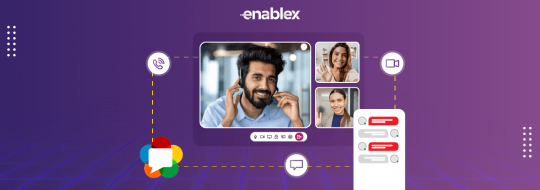
What a Live Video Streaming API
A live video streaming API (Application Programming Interface) allows developers to integrate video streaming capabilities into their applications or websites. This API enables you to stream video content to your audience in real-time, providing a seamless user experience. APIs abstract much of the complexity involved in streaming, including video encoding, delivery, and playback, allowing developers to focus on creating the best user experience possible.
Key Features to Look for in a Live Video Streaming API
When evaluating live video streaming APIs, there are several essential features you should consider:
Low Latency Streaming: Ensure the API supports low latency to minimize the delay between the live event and what your audience sees. This is crucial for real-time interaction, such as live sports events, gaming streams, or auctions.
Scalability: Your API should handle a large number of concurrent viewers without performance issues. Scalability is particularly important if you anticipate rapid growth or have plans to broadcast large events.
Adaptive Bitrate Streaming (ABR): This feature dynamically adjusts the video quality based on the viewer's internet connection, providing the best possible experience across varying network conditions.
Global Content Delivery Network (CDN) Support: The API should be backed by a reliable CDN to ensure smooth streaming across different geographic regions, reducing buffering and latency for viewers worldwide.
Security and DRM (Digital Rights Management): Protect your content from unauthorized access with features like encryption and DRM support. These are essential for premium content providers.
Recording and Archiving: Choose an API that supports recording live streams for later playback, which can add value for your audience who may want to access the content on demand.
Ease of Integration and Developer-Friendly Documentation
No matter how feature-rich an API might be, it needs to be easy to integrate into your existing systems. When evaluating APIs, consider the following:
Developer Documentation: Well-written, clear, and comprehensive documentation is essential for a smooth integration process. This should include code examples, SDKs, and a detailed guide to using the API.
SDK Availability: Software Development Kits (SDKs) for popular platforms (iOS, Android, web, etc.) can significantly speed up development. Ensure that the API offers SDKs in the programming languages you use.
Support for Multiple Platforms: The best APIs offer support across different devices and platforms, such as mobile, desktop, and smart TVs, ensuring your streams reach the widest possible audience.
Cost and Pricing Models
Cost is a significant factor when choosing a live video streaming API. Different APIs offer various pricing models, including pay-as-you-go, subscription-based, or usage-based pricing. When evaluating cost, consider:
Bandwidth Usage: Streaming video content consumes a lot of bandwidth, so understand how much bandwidth you’ll need and how the API provider charges for it.
Storage Costs: If the API offers recording and archiving features, assess how much storage you will need and the associated costs.
Scaling Costs: As your user base grows, so will your costs. Evaluate how the pricing scales as your audience increases to avoid unexpected expenses down the line.
Customization and Flexibility
Every business has unique requirements, so the best live video streaming API should offer customization options. Whether it’s customizing the player, adding overlays, or implementing unique interaction features like live chats or polls, flexibility is key.
API Customization: Look for APIs that offer customizable options, including control over video player design, layout, and features to match your brand’s identity.
Advanced Features: Depending on your use case, you might need advanced features such as real-time analytics, AI-based recommendations, or multi-camera streaming capabilities. Make sure the API you choose supports these needs.
Support and Reliability
When it comes to live streaming, reliability is critical. You can’t afford to have your stream go down during a crucial moment. Therefore, the quality of support provided by the API provider is just as important as the features it offers.
24/7 Support: Ensure the API provider offers round-the-clock support, especially if you’re broadcasting globally across different time zones.
Service Level Agreements (SLAs): Check if the provider offers a robust SLA that guarantees a certain level of uptime and performance.
Community Support: In addition to official support, active developer communities can be invaluable for troubleshooting and learning from others’ experiences.
Security and Compliance Security is a top priority when streaming live content, especially for paid or exclusive events. Look for the following security features in a live video streaming API:
Encryption: Ensure that your streams are encrypted to prevent unauthorized access during transmission.
DRM: If you’re streaming premium content, DRM can help protect your intellectual property from piracy.
GDPR Compliance: If you have viewers in the EU, ensure the API is compliant with the General Data Protection Regulation (GDPR) to avoid legal issues related to data privacy.
Popular Live Video Streaming APIs to Consider
EnableX : Experience seamless video streaming with EnableX HLS Streaming API, Real-Time Communication with high quality HTTP Streaming API, Sign Up Now for Free.
To help you get started, here are some of the most popular live video streaming APIs on the market:
Wowza Streaming Cloud: Known for its high-quality, low latency streaming and robust customization options. Wowza also offers a comprehensive suite of tools for managing, encoding, and delivering video content.
Agora: Offers low-latency, real-time communication APIs, ideal for interactive streaming like live gaming and virtual events. Agora also supports global scalability.
Mux: Mux offers powerful video APIs with adaptive bitrate streaming, live encoding, and video-on-demand capabilities. It’s known for its developer-friendly interface and real-time video analytics.
Vimeo Livestream API: Vimeo’s API provides powerful streaming capabilities, including video recording, live chat, and integration with various platforms. It’s an excellent choice for professional-grade broadcasts.
Twilio Live: Twilio Live is part of Twilio’s cloud communications platform, offering customizable, low-latency video streaming. It’s ideal for developers looking to build custom live streaming applications.
Evaluating Performance and Quality
Once you’ve narrowed down your list of potential APIs, it’s crucial to test their performance and video quality. Consider running pilot tests to evaluate:
Latency and Buffering: Assess the API’s performance under different network conditions to see how well it handles latency and buffering.
Video Quality: Evaluate the video quality across various devices and internet speeds, ensuring a consistent experience for all users.
Future-Proofing Your Streaming Solution
Technology is constantly evolving, and so are the demands of video streaming. When choosing a live video streaming API, consider its future capabilities:
AI and Machine Learning Integration: As AI continues to shape the streaming landscape, APIs that offer integration with AI-driven features like automated captioning, content moderation, or personalized recommendations can set you ahead of the competition.
Virtual and Augmented Reality (VR/AR) Support: With the rise of VR and AR, APIs that support immersive experiences could be an asset in the future.
Scalability for New Technologies: Ensure that your chosen API can scale with advancements in streaming technology, such as 4K and 8K streaming or new compression standards.
Choosing the right live video streaming API is critical to the success of your live streaming endeavors. By considering factors like latency, scalability, customization, security, and cost, you can find an API that meets your specific needs and ensures a high-quality streaming experience for your audience.
FAQs
Q. What is the best live video streaming API for low latency?
APIs like EnableX Agora and Wowza Streaming Cloud are known for their low latency streaming capabilities, making them ideal for real-time interactive events.
Q. How can I ensure the security of my live streams?
To ensure the security of your live streams, look for APIs that offer encryption and DRM (Digital Rights Management). These features protect your content from unauthorized access and piracy.
Q. What pricing model is most cost-effective for live streaming?
The most cost-effective pricing model depends on your usage. Pay-as-you-go models work well for smaller streams, while subscription-based or usage-based pricing is better for larger-scale, regular streaming.
Q. Do all live video streaming APIs support multi-platform streaming?
Not all APIs support multi-platform streaming out of the box. Look for APIs that offer cross-platform compatibility, including mobile devices, web, and smart TVs.
Q. How do I test the performance of a live video streaming API?
You can test the performance of a live video streaming API by running pilot streams and assessing metrics like latency, buffering, and video quality under various network conditions.
Q. What features should I prioritize for large-scale events?
For large-scale events, prioritize features like scalability, global CDN support, adaptive bitrate streaming, and robust security measures to ensure a smooth and secure experience for a large audience.
0 notes
Text
DRM Video Encryption Software or DRM Player to protect your video content
DRM video encryption software - Digital Rights Management (DRM) is a process that secures digital content such as video to prevent unauthorized use and piracy of copyrighted material. Accessing the content requires authentication of both the user and the period of time requested.
Our iShieldProtect® content security solutions provide security to your digital content to avoid piracy and illegal usage.
iShieldProtect® offers 128-bit DRM video encryption software with DRM Player which protects your videos and content from unauthorized access.
Dissuading from Camera recording - Dynamic watermarks are displayed at different parts of video at random intervals with different information like Name, User ID, IP Address to dissuade students from camera capture.
Tamper proof license Based Security - License key will work only on a single machine identified on the basis of multiple parameters to ensure its uniqueness so that same license can never ever be used on 2 machines installed using cloning software.
Start your free trial now 9164006065
#DRM Video Encryption Software#DRM player#drm video protection software#drm player#drm protection software#drm video encryption#drm software for video#drmprotected video testing#drm protected video testing
0 notes
Text
Mastering Streaming Video Hosting for Beginners

Streaming Video Hosting has become a staple of media consumption, with platforms like YouTube, Netflix, and Twitch pushing the boundaries of how and where we watch videos. However, creating a smooth streaming experience requires meticulous attention to various technical and strategic factors. For content creators and streaming services, optimizing video content is crucial for reducing buffering, improving quality, and ensuring user satisfaction. This article explores the key strategies and technologies involved in optimizing video content for seamless streaming.
Understanding the Basics of Streaming Video Hosting
Streaming Video Hosting is the process of transmitting video files from a server to a user's device in real time. The user’s device decodes the data stream and plays the video without fully downloading it. To achieve seamless streaming, videos must be optimized in several ways, starting with compression and formatting.
Video Compression and Codecs
Video compression is essential to reduce the file size without significantly compromising video quality. Effective compression techniques make videos easier to transmit over various internet speeds. Codecs, which stand for "compressor-decompressor", are used to encode and decode digital video. Popular codecs include H.264, HEVC (H.265), and VP9. Each codec varies in terms of compression efficiency and compatibility with devices and browsers.
Adaptive Bitrate Streaming (ABS)
Adaptive Bitrate Streaming is a technique used to adjust the video quality in real time based on the viewer’s available bandwidth. ABS enhances the viewing experience by minimizing buffering and avoiding the degradation of video quality. Major streaming platforms utilize ABS to dynamically serve the best possible video quality at any given time.
Content Delivery Networks (CDNs)
Content Delivery Networks are another crucial element in optimizing video streaming. CDNs distribute the video content across various servers located in different geographical locations. When a user requests a video, it is served from the nearest server, which reduces latency, decreases buffering times, and improves load speeds.
Best Practices for Video Optimization
Beyond technical adjustments, several best practices can enhance the streaming video hosting experience:
Choose the Right Hosting Solution: Whether it’s a dedicated server, cloud hosting, or a CDN, selecting the right hosting solution based on the audience size and geographical spread is vital.
Opt for Multi-Bitrate Encoding: Offering multiple bitrate options allows the streaming video hosting service to adjust to different internet speeds and device capabilities.
Thoroughly Test Video Quality: Regular testing across different devices and network conditions is essential to ensure consistent video quality and functionality.
Monitor Analytics: Utilize analytics to understand viewer behavior, device usage, and network conditions to continuously refine streaming video hosting strategies.
Optimizing Mobile Streaming
With increasing mobile device usage, optimizing videos for mobile streaming video hosting is crucial. This includes ensuring that videos are encoded in mobile-friendly formats, using responsive design principles, and implementing touch-friendly player controls. Furthermore, considering the use of lighter mobile-specific codecs like VP9 can help in faster loading times and lower data consumption.
Enhancing User Experience (UX)
To ensure a seamless streaming video hosting experience, UX designers and developers should focus on creating an intuitive and engaging interface. Elements such as easy navigation, quick access to video controls, and minimal buffering contribute significantly to user satisfaction. Additionally, including features like video previews, quality selectors, and seamless transitions from one video to another can greatly enhance the viewing experience.
Facing Challenges in Streaming Video Hosting
Content creators and streaming video hosting services often face several challenges such as high bandwidth costs, varied internet speeds among users, and the need for massive scalability during peak times. To address these issues, implementing advanced compression technologies, using efficient transmission protocols, and scaling infrastructure dynamically are vital strategies.
Future Trends in Video Streaming
Looking ahead, emerging technologies such as AI-driven compression, edge computing, and 5G are set to revolutionize the streaming video hosting industry. AI can optimize encoding settings in real time for optimal quality and minimal bandwidth usage. Edge computing will help in processing data closer to the end user, reducing latency significantly. Additionally, the rollout of 5G technology promises substantially higher speeds and more reliable connections, which will further enhance streaming video hosting capabilities.
In conclusion, optimizing video content for seamless streaming video hosting involves a well-rounded approach that includes technical optimizations, strategic planning, and continual adaptation to emerging trends and technologies. By focusing on these aspects, content creators and streaming video hosting platforms can ensure high-quality, buffer-free experiences that meet the evolving demands of modern viewers. please don’t hesitate to contact us via email or phone for further assistance!
#streaming video hosting#cloud video platform#secure video hosting#drm encrypted video streaming#security video#drm software#online video platform
0 notes
Text
ott platform developers india
ott platform developers india

In the ever-evolving landscape of digital entertainment, Over-the-Top (OTT) platforms have emerged as game-changers, offering on-demand streaming services to a global audience. India, with its rich pool of tech talent and diverse content landscape, has become a hub for OTT development companies. These companies play a pivotal role in shaping the future of digital media consumption. This article explores the services provided by OTT development companies in India, their significance, and key considerations when choosing a partner for OTT development.
Services Offered by OTT Development Companies in India:
OTT App Development: OTT development companies specialize in creating intuitive and user-friendly applications that cater to diverse platforms, including smartphones, smart TVs, tablets, and computers. These applications are designed to provide a seamless streaming experience to users.
Content Management Systems (CMS): Robust content management systems are essential for organizing and delivering a vast array of content. OTT development companies in India provide scalable CMS solutions that facilitate efficient content organization, categorization, and delivery.
Video Streaming Solutions: High-quality video streaming is a cornerstone of OTT platforms. Development companies create solutions that optimize video delivery, implement adaptive bitrate streaming, and enhance user experience with features like pause, rewind, and resume.
Monetization Strategies: Implementing effective monetization models is crucial for the success of OTT platforms. These companies assist in integrating various revenue streams, including subscription-based services, pay-per-view, and advertising, along with secure payment gateways and billing systems.
User Authentication and Security: Security is paramount in the OTT industry. Development companies implement robust user authentication mechanisms, content encryption, and Digital Rights Management (DRM) to protect intellectual property and ensure a secure streaming environment.
Analytics and Insights: Understanding user behavior is critical for content optimization and business strategy. OTT development companies provide analytics tools to track user engagement, content preferences, and other key metrics, enabling data-driven decision-making.
Cross-Platform Compatibility: OTT development companies ensure that applications are compatible with various devices and platforms, offering a consistent and seamless experience to users regardless of the device they use.
Significance of OTT Development Companies in India:
Rich Talent Pool: India is renowned for its skilled workforce in software development, engineering, and creative fields. OTT development companies leverage this talent pool to deliver cutting-edge solutions that meet global standards.
Cost-Effective Solutions: The cost of development in India is often more competitive compared to other regions. OTT development companies offer cost-effective solutions without compromising quality, making them attractive partners for businesses worldwide.
Diverse Content Creation: India's cultural diversity translates into a vast content landscape. OTT development companies tap into this diversity to create platforms that cater to a wide range of audience preferences, languages, and genres.
Global Partnerships: Many OTT development companies in India have established global partnerships and collaborations. This enables them to bring in international best practices, technologies, and content licensing agreements to enhance their clients' offerings.
Choosing the Right OTT Development Company in India:
Portfolio and Expertise: Evaluate the portfolio of the OTT development company to gauge their expertise and experience. Look for a company that has successfully delivered projects similar to your requirements.
Technology Stack: Assess the technology stack used by the company. Ensure that they are adept at using the latest technologies and frameworks to develop scalable and feature-rich OTT platforms.
Security Measures: Security is a critical concern in the OTT industry. Ensure that the development company has robust security measures in place, including content protection, encryption, and secure user authentication.
Scalability: Choose a company that understands the importance of scalability. As your user base grows, the platform should be able to handle increased demand without compromising performance.
Client Reviews and Testimonials: Read client reviews and testimonials to get insights into the satisfaction levels of previous clients. Positive feedback is indicative of the company's reliability and the quality of their services.
Regulatory Compliance: The OTT industry is subject to various regulations and compliance requirements. Ensure that the development company is aware of and adheres to these regulations to avoid legal complications.
#ott#ott develops#ott development#ott develop#online marketing#digital marketing#website design#webdevelopment#website designing
0 notes
Text
3 key challenges in OTT content delivery
Are you seeking to stay ahead in the rapidly evolving over-the-top (OTT) content delivery landscape? If tackling this significant challenge seems daunting, fret not! This blog post will delve into the three primary challenges that any OTT service provider may encounter. Whether you’re a seasoned professional or a newcomer to the industry, this post will offer valuable insights and advice on overcoming these obstacles to establish and sustain an integrated video delivery platform successfully. Get ready for an in-depth exploration of OTT content delivery success! We are live streaming service provider in India & online streaming platform in India
Understanding OTT Platforms
An Over-the-Top (OTT) platform is a streaming service that delivers video content over the internet, bypassing traditional cable or broadcast television providers. These platforms, aptly named ‘over-the-top,’ operate on top of existing internet infrastructure without the need for a dedicated network.
Netflix serves as an example of an OTT platform, offering a subscription-based service enabling users to stream TV shows, movies, and other video content on-demand over the internet. Users can access the platform on various devices such as smart TVs, computers, smartphones, and tablets. Apart from licensed content, Netflix produces original programming. Other examples of OTT platforms include Hulu, Amazon Prime Video, Disney+, HBO Max, and Apple TV+.
Key Challenges in OTT Content Delivery
Bandwidth and Network Capacity:
Online streaming success hinges on adequate bandwidth and network capacity. Network congestion and bandwidth limitations can lead to buffering, degraded video quality, and interruptions in the viewing experience. To maintain customer loyalty, providers must ensure a seamless streaming experience. Collaboration with Internet Service Providers (ISPs), investment in Content Delivery Networks (CDNs), and adoption of adaptive bitrate streaming technology are essential strategies to address these challenges. We are live streaming service provider in India Possible Solutions:
Implement Adaptive Bitrate Streaming technology.
Leverage Content Delivery Networks (CDNs).
Explore Peer-To-Peer Technology.
Optimize Network Performance.
Embrace 5G Technology.
Content Delivery & Infrastructure:
Successful OTT content delivery requires a robust infrastructure capable of handling large data volumes. Investments in hardware, software, and networking equipment are crucial. Video encoding, transcoding technology, content management systems, and monetization systems play pivotal roles in enhancing efficiency and generating revenue. We provide online streaming platform in India
Possible Solutions:
Utilize Video Encoding and transcoding.
Adopt Edge Computing.
Implement Content Delivery Networks (CDNs).
Leverage Advanced Analytics.
Invest in Network Infrastructure.
Implement Monetization Systems.
Content Protection & Piracy:
Protecting content from illegal copying or distribution is crucial for revenue streams. Digital Rights Management (DRM) technologies, watermarking, encryption, and access control are vital measures. Content piracy poses a significant threat, impacting revenue and user experience. Strategies include DRM technology, watermarking, industry collaboration, user education, and legal action.
Possible Solutions:
Implement Digital Rights Management.
Employ Watermarking.
Foster Industry Collaboration.
Educate Users.
Take Legal Action.
Final Thoughts:
Mogi, with over a decade of experience, stands ready to empower organizations with tailored digital solutions for OTT and broadcasting technologies. Mogi offers end-to-end solutions and ensures that your organization has the right tools to thrive in the digital landscape. Contact Mogi today for personalized digital solutions that will elevate your business.
Want to Build the Next Big OTT Platform? Book Your Free Demo Today! See how Mogi works through a 1-to-1 demo with our product experts.
#OTTServices#OTTSolution#streaming#videoplatforms#videostreaming#mogi#vod#whitelabelott#videoplatform#livestreaming#videoondemand#vodsolution#ottplatform#entertainment#media#whitelabelsolution#audiostreaming#livestreamingplatform#ottappdevelopmentservices#MediaStreaming#VideoMonetization#Broadcasting#VideoManagement#DigitalStreaming
1 note
·
View note
Text
Safeguarding Your Creative Work: A Comprehensive Guide to Content Security
In today’s digital age, content is king. Whether you are a content creator, a business owner, or an individual sharing your thoughts online, the ownership and security of your content are paramount. Protecting your IP and ensuring that your content remains safe from theft, plagiarism, or unauthorized access is crucial. In this blog, we will explore effective strategies for ensuring the safety and security of your content.
Understanding Content Ownership
Before we delve into the best practices for content security, we must understand content ownership. Content ownership refers to the legal rights and control over the content you create, whether it is a blog post, a video, a piece of software, or any other digital asset. These rights grant you the ability to use, share, and monetize your content while preventing others from doing the same without your permission.
Best Practices for Content Security
Copyright Protection
Copyrighting your content is one of the most effective ways to secure your content ownership. Copyright gives exclusive rights to your work, including the right to reproduce, distribute, and display it. This legal protection acts as a strong deterrent to potential content thieves.
Watermarking
Consider adding watermarks if you create visual content such as images or videos. Watermarking involves overlaying your name, logo, or other identifying information onto your content. This not only brands your work but also discourages unauthorized use, as it becomes visibly clear who owns the content.
Digital Rights Management (DRM)
For digital content distribution, consider using DRM tools and technologies. DRM allows you to control how your content is accessed, copied, and shared. It can restrict access to authorized users and prevent unauthorized distribution.
Strong Passwords and Authentication
Protect your digital assets by using strong, unique passwords for your accounts and content management systems. Enable multi-factor authentication whenever possible. Strong passwords make it much harder for unauthorized users to access your content.
Collaborate Securely
If you collaborate with others on content creation, establish clear agreements about ownership, usage rights, and security practices. Ensure that everyone involved understands their responsibilities regarding content security.
Secure Hosting and Storage
If you rely on external hosting or cloud storage services, choose reputable providers with robust security measures. Ensure that they offer encryption, as well as other security features like firewalls and intrusion detection systems.
Conclusion
Safeguarding your ownership rights is crucial in a digital world filled with valuable content. Implementing the best practices for content security outlined in this blog will help you protect your intellectual property, maintain control over your creations, and minimize the risk of unauthorized use or theft.
Remember that content security is an ongoing process. Stay vigilant, adapt to new challenges and technologies, and, when necessary, seek legal remedies to enforce your ownership rights. By following the above practices, you can enjoy the benefits of content creation while keeping your creations safe and secure in the digital realm.
For further insights, please visit https://myipr.io/, the world’s first intellectual property management cloud. MyIPR uses advanced timestamping technology to provide a certificate of creation, along with a digital signature, to ensure your intellectual property is secure.
0 notes